More living than dead people on statues and sculptures in 2023
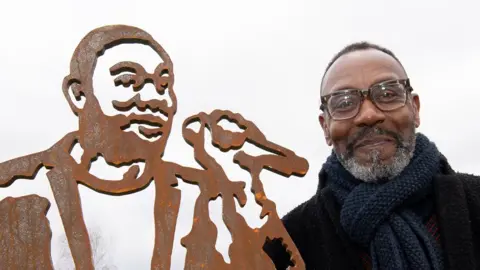 Sustrans
SustransMore living people than dead people were depicted on statues and sculptures in 2023, according to new data seen by BBC News.
It is the first time this century that this has happened and reflects a drive to celebrate more people of colour, said Art UK, which compiled the data.
More than a third of all monuments unveiled last year are of black people.
But overall, the people depicted in public sculpture remain "overwhelmingly white men", the charity said.
Only 2% of public statues - defined as those in the public realm - across the UK are dedicated to people belonging to ethnic minorities figures, while just 17% are of women, its figures show.
"With so many public artworks dedicated to white men across the UK, installed over hundreds of years, it is unlikely that the balance will ever be redressed," said Art UK.
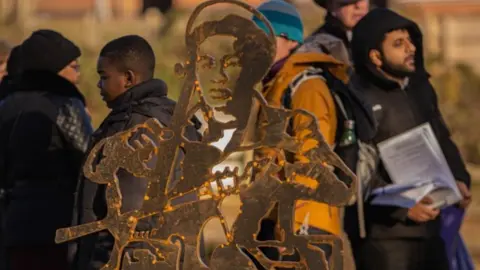 Sustrans/Curtis Powell
Sustrans/Curtis PowellTwenty six named people were depicted in the new sculptures put up across the UK last year, according to Art UK.
Of the 26, 11 commemorate people who have already died, while 15 honour people who are still alive.
Ten were black men and women, all of whom are either still alive or have recently died.
They include cellist Sheku Kanneh-Mason, 24, who was honoured last April with a steel tribute in Nottingham, where he is from.
A steel sculpture depicting comedian Sir Lenny Henry, 65, was unveiled in a park in Birmingham last February.
"By commemorating living people, you're able to shine a light on a much more diverse group of people," Katey Goodwin, deputy chief executive of Art UK, told BBC News.
"These are groups of people whose stories haven't been heard, or have been hidden, due to the way that history has been written. So it's about pulling out those stories."
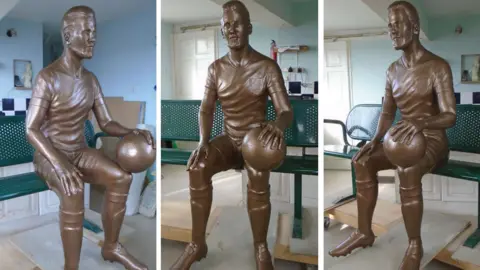 Sculpture Machine Ltd
Sculpture Machine LtdThe trend to commemorate living people has continued this year.
Earlier this month, images of a statue of England's 30-year-old football captain Harry Kane were revealed ahead of it going on display.
But does getting a statue at a young age put a lot of pressure on the individual?
"I think it's down to that individual and how they perceive it," said Ms Goodwin. "Most people are probably delighted to have a statue made of them. How they might feel about the statue in future... remains to be seen."
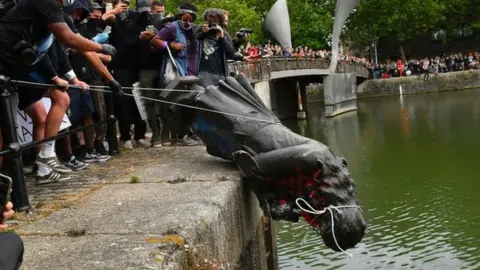 PA Media
PA MediaStatues around the world were defaced as part of the Black Lives Matters protests, which swept the globe in 2020.
In Bristol, protesters tore down a statue of merchant and slave trader Edward Colston, sparking a national debate about how Britain's history is remembered.
There has also been criticism of the lack of monuments to women in public spaces.
An audit by Art UK three years ago found London has twice as many statues of animals as named women.
"If humankind vanished tomorrow and aliens arrived from another galaxy, they wouldn't be faulted for believing that the whole of human history was composed of men on horseback," a 2021 comment piece by the New York Times observed.
In recent years, various initiatives have been set up to try and improve diversity in the country's public spaces.
London mayor Sadiq Khan set up a taskforce in the wake of the Black Lives Matters protests, to look at the city's statues, street names and memorials and "ensure we tell the full story of our capital".
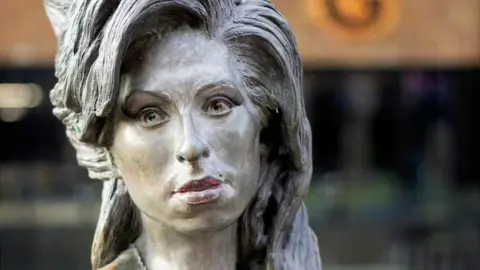 Art UK
Art UKArt UK's latest figures show an uptick in the number of black people being commemorated across the country in 2023. In 2022, only one monument of a black person was put up, compared with 10 last year.
But there were no statues of people belonging to other other ethnic minorities unveiled in 2023, according to the data.
Of the 26 people commemorated last year, 14 were men and 12 were women.
Even then, the number of women was outnumbered by the number of animals, according to Art UK.
Women who did get honoured include Paralympian swimmer Ellie Simmonds, weightlifter Emily Campbell, and author Agatha Christie.
"The sculptures unveiled in 2023 have not made a large contribution to redressing the balance of people celebrated in public art," said Art UK.
"Overall, the people depicted and commemorated in public sculpture are still overwhelmingly white men."
The Fawcett Society, an equal-rights charity, said it was "a crying shame" that women, and particularly women of colour, were still vastly under-represented by public sculptures.
"It is surely worth considering who we, quite literally, put on a pedestal and why," its director of policy, Alesha De-Freitas, told BBC News.
"Public space is for everyone and should reflect our ambitions for an equal world - not an antiquated, sexist past."
The Race Equality Foundation said it was "crucial" to increase the representation of people belonging to ethnic minorities, across the UK.
The charity said that having a wide range of statues helped to educate society about the diversity of British history and the significant roles played by people from various ethnic backgrounds.
However, it said that while having more diverse statues was important, it should not overshadow "the urgent need to address structural racism and systemic inequalities".
"Statues are just one part of a broader strategy to combat racism and promote social justice in the UK," its spokesperson added.
